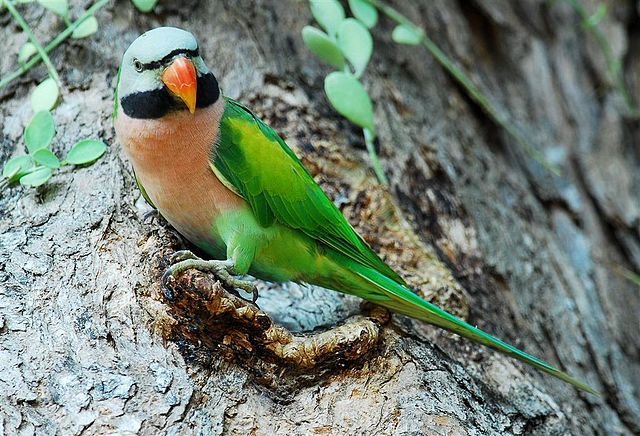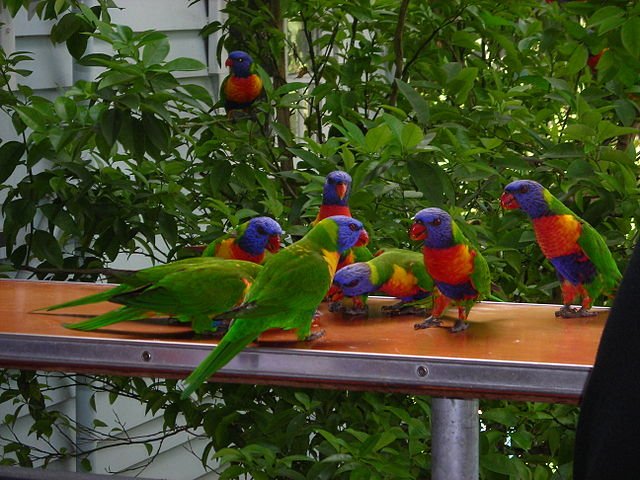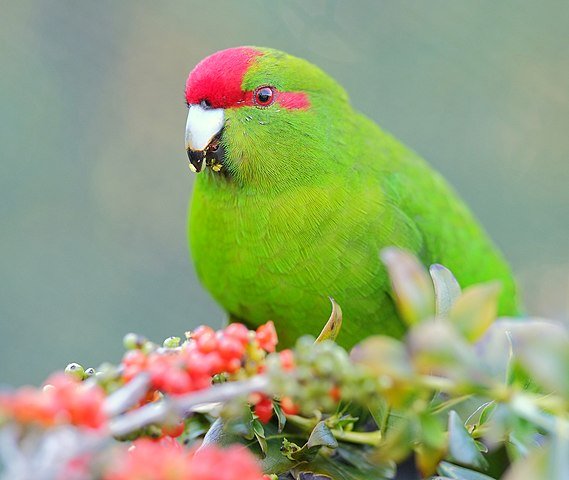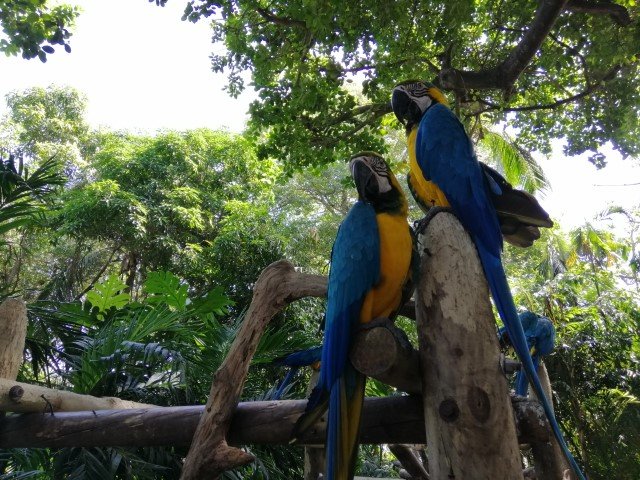It most definitely amazes people why an animal, especially a bird, is called a Moustached Parakeet. The black-colored feathers from one eye to the other, right above its beak, looking like a man’s well-groomed mustache, is the reason for that name. Moustache Parakeet is also called Red-breasted Parakeets. The latter is because of the red color on the breast.
The Moustached Parakeet is a type of parrot that has its range in Southern Asia and is mainly found in China and the islands of Indonesia. Though they are not common like some parrots, they are beginning to become more popular because they make such a good pet in the home. Some people might chose to not keep parrot as pets because they are noisy. However, a mustached Parakeet is different because they have been found quieter than the other types of parrot.
If you have always been searching for a parrot that is not noisy and can be your companion, then you should consider the Moustached Parakeet. There are other reasons why you might end up getting a Moustached Parakeet, and if you have gotten one already, there is so much to learn about it.
Lifespan
Under good care and condition, they live about 20-25 years. That’s a significant number of years to have your pet around.
Personality and Behaviour
If you want a medium-sized parrot with many personalities, the Moustached Parakeet is the bird for you. This bird is well-known for its intelligence and playful character. They love a lot of attention and can be attached to one person. Like any other parrot they can be aggressive towards people. If a Moustached Parakeet is not well socialized, they find it difficult to get along with people and they can become aggressive.
They tend to act bossy and demand a lot of attention. If they ever feel ignored by their owners, they show that they want their attention by acting towards them. They do not enjoy cuddling like some pets, but they can still get familiar with it if nestled frequently. They, however, welcome soft pats at the back of the neck. They like perching on their owners’ shoulders and will only do that to one person they have chosen as their companion, most of the time their caregivers.
They also exhibit aggressive behaviors like most Asian species during adolescence. They are found intelligent and can be easily trained, at the same time challenging to train if you start when they are adults already. They are also found opinionated and are, however, considered stubborn by some owners. Hand feeding them as chicks really helps with behavioral problems. They should be given toys and things to chew on as this can help the taming process and also help stimulate the intelligent bird.
They are quite inquisitive and love to explore. Don’t be surprised when you find them interested in the things you do in the house. If they are given the opportunity, you can find them anywhere in the house, trying to figure out everything in the house.
Talking Ability
The Moustache Parakeets are great talkers. They have excellent talking abilities. Many owners get this wrong, and they end up getting disappointed. They can talk does not mean they must talk. They can learn how to talk, but at the same time, they might not talk. Owners should get it right before they get a Moustache Parakeet for its talking ability.
If trained to talk, with enough patience from the owner, they can become great talkers. Mustache Parakeets are, however, calmer than most parrots. They can go unnoticed in a house as they don’t make a noise like other parrots.
Moustache Parakeet in the wild
In the wild Moustached Parakeets move in large flocks. There’s enough space in the wild to accommodate a lot of them, and because of this, they move in flocks ranging between 20 to 60 birds. They are usually loud because they move in Mass, and the noise announces them before their arrival. Typically, they make a loud call when danger is near, like most Asiatic parrots.

Mustached Parakeets do not usually move with other types of parrot, but they have been seen doing that on rare occasions. Usually, they thrive in woodlands, mountains, and hilly areas; but due to habitat destruction, they have no choice but to manage the urban areas. That’s why you see them eating bread crumbs and picking different things at bus stations. But in the wild, they feed on seeds, fruits, and grains.
They have been found to breed around April. When it’s time to breed, they pair off to look for a suitable hole to produce their offspring. When the female finds an old hole inside a tree, she takes her time to modify it to her liking before she starts to lay eggs. While she lays the eggs, the male is usually there to guard and feed the hen till the end of the process.
Chicks that make it to seven or eight weeks leave the nest around that time as independent Moustached Parakeets.
Moustache Parakeet in captivity
Unlike the Indian Ringneck and Alexandrine, Moustached Parakeets are not usually found in captivity. They are found mainly by collectors specializing in Asiatic parrots or breeders in the Europe and United States bird clubs.
Unfortunately, the breeders do not see these birds as pets but rather as aviary ornaments.
Mustached Parakeets Diet
The Red-breasted Parakeets feed on fruits, grains, seeds, vegetables, and nuts in the wild and, because of that, are considered pests rather than pets by farmers who fall victim to these birds. The Moustache Parakeets in captivity also love to feed on varieties of diets.
Unlike some birds that love to feed only seeds and grains, Moustache Parakeets do well with the mixture of Pellets, fresh and raw fruits like orange, peeled apples, strawberries, fresh vegetables such as spinach broccoli, and carrots. Also, with a small amount of protein, such as hard-boiled eggs.
When feeding them seeds and grains, always serve them in small quantities because they only contain a part of the nutrient needed. Seeds have a large amount of fat. If you feed your bird a large number of seeds, they can become obese, making them prone to sickness.
The Moustache Parakeets also love cooked sweet potatoes. They can be fed cooked rice and beans. They also love to eat corn, especially on the cob after it is cooked for a short time. Be careful when serving them farm produce, be sure it is pesticide-free, and wash them thoroughly before you serve them to your birds.

Avocados should never be given to your birds because they are poisonous to birds. Also, remember to remove uneaten produce as quickly as possible, so it doesn’t get rotten before the bird feeds on it. Mustache Parakeets love peanuts and spray millets, but they should be given to them occasionally as treats or rewards for obeying you.
Mustached Parakeets Training
Most training with birds like the Moustache Parakeets goes wrong because owners believe that their birds can perform magic. The first thing to note is that training a parakeet requires time and patience. The second is there are specific techniques that you can apply to get your results.
The first thing to do is to create a comfortable environment. There’s much a Moustache Parakeet can do in a relaxed environment. That way, they feel secure and safe and ready to learn whatever you have to teach them.
Talk to your bird. If you want to train your mustache Parakeet to talk, you have to do that a lot. The more you talk to your bird, the more it gets familiar with your voice. The familiar it gets, the more it speaks to you. Then you can use the reward strategy; reward the bird whenever it does what you ask it to do. With time, the bird will understand that it gets something whenever it does what you say and gets nothing for disobedience.
Step Up
The “step-up” command is the basics of every other action. It is easy for a bird to learn different things if it can learn to step up. Get a perch in the bird’s cage and teach it to step upon it. It would help if you said the word “up” whenever you want to mount the perch. Gradually, the bird will begin to associate the word with the action then you can start to put your finger at the end of the perch while repeating the command word. In no time, the bird will understand your message clearly.
Also, you can train your bird to wave hello. Put the perch in front of you after the bird has learned the step-up command. Utter the word “hello” softly after nudging its chest. That way, the bird will know that “hello” is a new word. It is usual for the bird to lift its leg to step on your fingers. When you see it coming, slowly take away your finger to make the bird realize that it is meant to put the foot up in the sky and not climb on something.
Gender Identification
Unlike some monomorphic parrots, Moustached Parakeets are dimorphic, which means you can easily distinguish between the male and the female by looking at them even though they all have greenish-blue plumage on their tails.
The males have longer tail feathers, bright pink breasts, and an orange beak with a yellow tip. In contrast, the Females have short tail feathers, soft pink breasts with black beaks.
Suppose you find some with light pink beaks, incomplete cheek strips, and shorter tails, then you have found an immature bird. Both Male and Females have gray skin on their feet. The color on their wings is yellow patches intermixed with lime green.
Cage for Mustached Parakeets
Mustached Parakeets need a large cage to fly about, explore, and maintain their health. They should be provided with a small Alexandrine Parakeet or macaw cage with 3 x 2 x 3 ft as the minimum size. You can also make the size bigger if it suits your budget.
Make the wires 10 or 12 gauge because these birds can break a thin wire easily to explore and check out your home. The bar spacing should not be more than half an inch; else, the Parakeet stuck its head in it.
A grill should be provided at the bottom of the cage to prevent the birds from feeding on its droppings and eating contaminated foods. The cage should also have wooden perches of 1-inch or three diameters placed at different levels. Water bowls or food bowls should not be placed under perches.
Toys and swings should be provided for your pet’s enhancement.
Mustached Parakeets Breeding
Mustached Parakeets in the wild naturally pair themselves when breeding, but those raised as pets or for breeding should be paired at a young age as possible. The birds in the wild have been familiar with one another for a long time hence ease in pairing up.
The Moustache parakeets are usually ready for breeding between the age of two and three. When they have attained the breeding age, place a big nest box in the cage or wherever you keep the birds. The nest box should be close to the cage and placed opposite the opening of the cage. The nest box close to the cage will make the birds feel safe and secure. The nest box should be filled with necessary materials like wood shavings.
The health of the birds is as important, if not more important, than other things. The parrots must be healthy to breed successfully. Therefore it is essential to give them a nutritious and healthy diet. The diet should consist of Pellets, together with fresh fruit and vegetables. Add vitamin supplements and feed them calcium-rich food like cuttlebones to help the hen replenish its lost nutrients. Also, provide soft pieces of wood or papers that the bird can chew on while breeding. Most female parrots like to chew on something while breeding as it stimulates breeding in some cases.
After you have made everything the birds need available, you should leave the female and male birds alone as they like to have their privacy when mating.
Bathing Parakeets
While dogs and cats are taken to the shower to have a proper bath, bird owners do not know if they can bathe their birds and how to go about it. The exciting news is that it is safe to bathe Parakeets. Bathing them regularly helps them stay healthy.
The Parakeets have different bath options; you can choose the most preferred method based on the bird’s reaction to water. While some Moustached Parakeets love water without any condition, some are afraid of water and require extra steps to get used to bathing. These are the steps to take to get your bird used to having a proper bath:
Spritz your bird gently with lukewarm water from a spray bottle. Watch the bird’s reaction as you gradually introduce her to water. If she loves what you are doing, she would spread her wings and ruffle her feathers. She may also make a play face at you by gaping at her beak, trying to drink the water. That is its way of saying she wants more. If the bird shows signs of loving the spray method, you can settle for that as a way of bathing your bird or move to the last method. However, if she doesn’t enjoy the spray method, there is one more thing to do.
Place a shallow water dish in the bird’s cage and present its favorite treats near the water dish. This is to make your bird fall in love with water while munching on the tempting treats. If your bird later develops a love for water through this method, you can go back to the spray method or leave her to take care of her hygiene without worries. While this method sounds easy and good, it can be dangerous because the bird can mistake its bathing water for drinking water if care is not taken.
The last method is called the shower method. This method requires you to take your Parakeet into the bathtub or shower with you. Spray her gently with the handheld shower nozzle with mildly warm water. This method can only be used for Parakeets that love water or those that have gotten used to the spray method. Know that no method is compulsory as long as your bird has its bath somehow; you do not have to force it into taking a method.
Common health problems
The Moustache Parakeets are strong birds and will hardly fall sick if appropriately fed. However, they can be susceptible to a few conditions such as:
- Polyoma caused by a deadly avian virus
- Psittacosis (parrot fever)
- Vitamin A deficiency
- Aspergillosis
- Sarcocystosis
- And other Bacteria infections.
Featured Photo Credit: Flickr user NatureAtYourBackyard, CC BY 2.0




What is the price range?
Are they available in the USA?
Where can I find a mustached parakeet in crystal lake Il